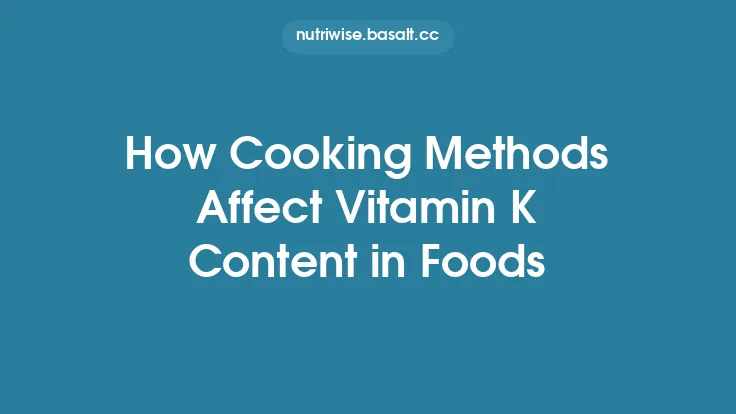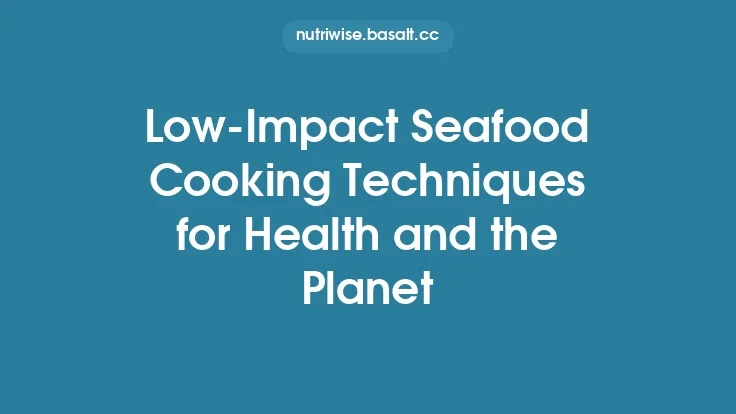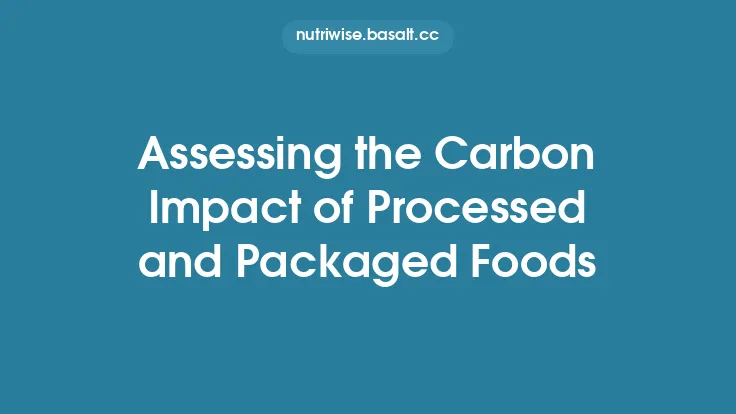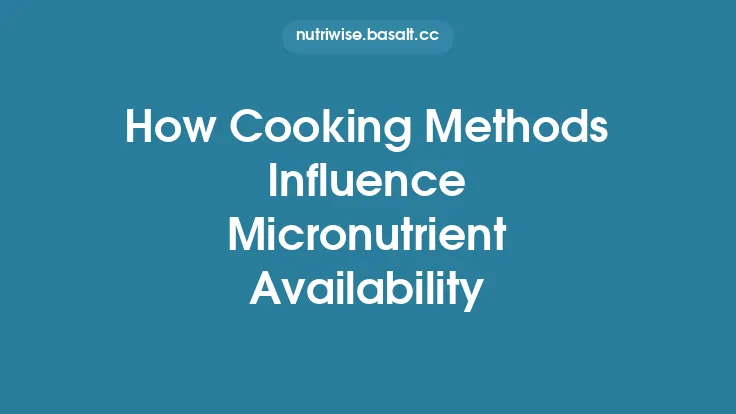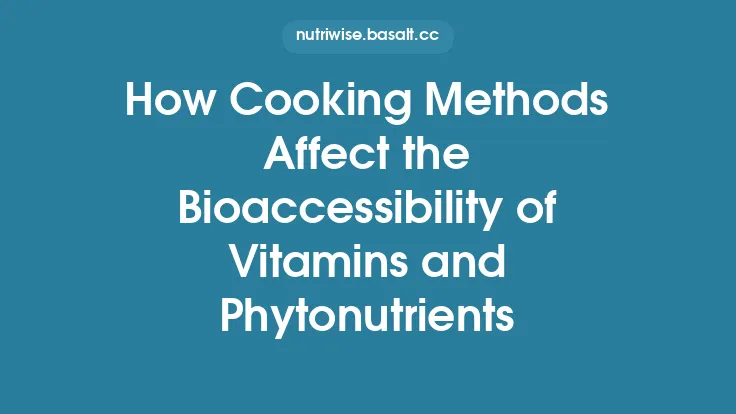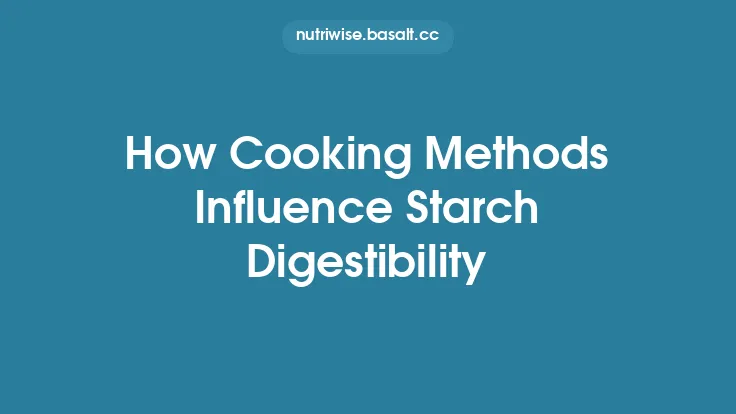Cooking is one of the most visible daily activities that contributes to a household’s overall carbon footprint, yet it is often overlooked in discussions about sustainable food systems. The energy required to transform raw ingredients into a finished meal can vary dramatically depending on the method used, the appliance’s efficiency, the fuel source, and even the choice of cookware. By understanding the mechanisms behind heat transfer, the carbon intensity of different energy carriers, and the ways in which cooking practices can be optimized, consumers can make informed decisions that reduce emissions without sacrificing flavor or nutrition.
Energy Sources and Their Carbon Intensity
The first determinant of a cooking method’s carbon impact is the type of energy that powers the appliance. In most regions, electricity and fossil‑based gases (natural gas, LPG, propane) dominate household cooking. Their carbon intensities differ not only by fuel type but also by the generation mix of the electricity grid.
| Energy Carrier | Typical CO₂e Emission Factor* | Common Appliances |
|---|---|---|
| Electricity (grid average) | 0.3–0.7 kg CO₂e kWh⁻¹ (varies by country) | Electric ovens, induction hobs, microwaves, electric kettles |
| Natural Gas | 0.18–0.22 kg CO₂e kWh⁻¹ (combustion) | Gas stovetops, gas ovens, gas grills |
| LPG/Propane | 0.20–0.25 kg CO₂e kWh⁻¹ | Portable gas burners, outdoor grills |
| Renewable Electricity (e.g., solar, wind) | <0.05 kg CO₂e kWh⁻¹ (life‑cycle) | Same as electric appliances when powered by renewables |
\*Values are approximate and represent life‑cycle emissions per unit of useful energy delivered to the appliance.
When electricity is sourced from a low‑carbon grid, electric cooking methods can be substantially cleaner than gas, even if the electric appliance is less efficient. Conversely, in regions where the grid is heavily coal‑dependent, gas cooking may emit less CO₂e per meal. Therefore, the carbon advantage of a particular method is context‑specific and should be evaluated against the local energy mix.
Heat Transfer Efficiency of Common Cooking Techniques
The efficiency with which an appliance converts fuel into usable heat directly influences emissions. Efficiency is defined as the ratio of heat transferred to the food (useful heat) to the total energy input.
| Cooking Method | Typical Efficiency* | Key Heat Transfer Mechanism |
|---|---|---|
| Boiling (electric kettle) | 80–90 % | Direct conduction from heating element to water |
| Steaming (electric steamer) | 70–80 % | Conduction + convection of steam |
| Microwaving | 60–70 % | Dielectric heating of water molecules in food |
| Conventional Oven (electric) | 10–15 % | Radiant heat losses through walls and venting |
| Conventional Oven (gas) | 20–30 % | Combustion heat, with some loss through exhaust |
| Induction Hob | 85–90 % | Electromagnetic induction directly heating cookware |
| Pressure Cooking | 70–80 % | Trapped steam raises pressure, raising boiling point |
| Deep Frying (oil) | 30–40 % | Heat loss to ambient air and oil degradation |
| Grilling (charcoal) | 10–20 % | Radiant heat, significant loss to surroundings |
\*Efficiency ranges are typical for well‑maintained appliances; actual values can vary with age, maintenance, and usage patterns.
Why efficiency matters: A method with low efficiency (e.g., a conventional electric oven) requires more energy to achieve the same cooking result as a high‑efficiency method (e.g., induction or pressure cooking). The extra energy translates directly into higher CO₂e emissions, especially when the energy source is carbon‑intensive.
Water Use and Its Indirect Emissions
Water is a hidden contributor to cooking‑related carbon emissions. Heating water consumes energy, and the amount of water used can differ dramatically between methods.
- Boiling vs. Steaming: Boiling a pot of water for pasta may require 1–2 L of water per 100 g of dry pasta, while steaming the same amount of vegetables typically uses only the water needed to generate steam (often <0.5 L). The lower water volume reduces the energy needed for heating.
- Pressure Cooking: Because the vessel is sealed, pressure cookers need far less water than open‑pot boiling, cutting both water and energy use.
- Microwaving: Moisture already present in the food is heated directly, eliminating the need for added water in many cases.
The carbon impact of water heating can be estimated using the specific heat capacity of water (4.18 kJ kg⁻¹ °C⁻¹). For example, heating 1 L of water from 20 °C to 100 °C requires roughly 0.33 kWh of energy. If the electricity grid emits 0.5 kg CO₂e kWh⁻¹, that single liter of boiled water adds about 0.17 kg CO₂e to the cooking process. Multiplying this by the number of liters used per meal quickly shows the emissions advantage of low‑water methods.
Cookware Materials and Their Influence on Energy Demand
The thermal properties of cookware affect how quickly and evenly heat is transferred, which in turn influences cooking duration and energy consumption.
| Material | Thermal Conductivity (W m⁻¹ K⁻¹) | Typical Impact on Cooking Energy |
|---|---|---|
| Copper (core) | 400 | Very high conductivity; reduces heating time, especially on induction or gas. |
| Aluminum (anodized) | 237 | Good conductivity; lightweight, quick heating. |
| Stainless Steel (solid) | 16 | Poor conductivity; often requires a thicker base or an aluminum core to improve performance. |
| Cast Iron | 55 | High heat capacity; retains heat well, ideal for searing and slow cooking, but slower to heat up. |
| Ceramic (non‑metal) | 1–2 | Very low conductivity; best for low‑heat, slow cooking; higher energy use for rapid tasks. |
A pan with a high‑conductivity base reaches the target temperature faster, allowing the stove to be turned off sooner or the cooking time to be shortened. Conversely, low‑conductivity cookware may require higher burner settings and longer cooking periods, increasing fuel consumption. When paired with an induction hob, cookware that contains a ferromagnetic layer (e.g., stainless steel with an iron core) maximizes the efficiency of the electromagnetic heating process.
Batch Cooking and Residual Heat Utilization
Cooking multiple portions in a single session can dramatically lower per‑serving emissions by spreading the fixed energy cost of preheating and by exploiting residual heat.
- Oven Residual Heat: After reaching the desired temperature, an oven retains heat for 30–60 minutes. Using this residual heat to finish cooking or to keep dishes warm eliminates the need for a second heating cycle.
- Stovetop Carry‑Over: When a pot is removed from the burner, the contents continue to cook for several minutes due to stored thermal energy. Planning recipes to finish during this carry‑over period can shave off a few minutes of active heating.
- Pressure Cooker Stacking: Modern multi‑layer pressure cookers allow simultaneous cooking of different foods (e.g., rice at the bottom, vegetables in a stacked tray). The same steam and pressure cook both items, reducing total energy use compared to separate pots.
Batch cooking also reduces the number of times appliances are turned on and off, which can be significant for devices with high standby power draws (e.g., electric ovens that maintain a “keep‑warm” mode).
Emerging Low‑Carbon Cooking Technologies
Innovation is reshaping the kitchen landscape, offering alternatives that can lower carbon emissions even further.
- Induction Cooking – By generating heat directly in the cookware via magnetic fields, induction eliminates the need to heat the surrounding air, achieving efficiencies of 85–90 %. When paired with renewable electricity, its carbon footprint can be among the lowest of all cooking methods.
- Air Fryers – These appliances circulate hot air at high speed, achieving crisp textures with 30–40 % less oil and often 20–30 % less energy than deep frying. Their compact size also reduces heat loss to the kitchen environment.
- Solar Ovens – Using reflective panels to concentrate sunlight, solar ovens can reach temperatures of 150–200 °C without any fuel input. While weather‑dependent, they provide a zero‑emission option for slow‑cooking dishes such as stews and baked goods.
- Microwave‑Assisted Hybrid Ovens – Combining conventional convection heating with microwave energy reduces cooking times by up to 50 %, cutting energy use proportionally. The hybrid approach also preserves moisture, potentially reducing the need for added water.
- Smart Cooking Controllers – IoT‑enabled devices can monitor temperature, adjust power in real time, and shut off appliances when the target is reached, preventing over‑cooking and unnecessary energy consumption.
Practical Strategies for Reducing Cooking‑Related Emissions
Even without purchasing new appliances, everyday habits can lower the carbon intensity of cooking:
- Match Pot Size to Burner: Using a small pot on a large burner wastes heat. The flame or heating element should just cover the bottom of the vessel.
- Cover Lids: Keeping lids on pots reduces heat loss, cutting cooking time by 10–30 % for boiling, steaming, and simmering.
- Pre‑Heat Efficiently: For electric ovens, pre‑heat only to the temperature required for the recipe; many dishes (e.g., casseroles) can be started in a cold oven and still achieve proper cooking.
- Utilize Residual Heat: Turn off the stove or oven a few minutes before the food is fully cooked; the remaining heat will finish the process.
- Choose High‑Efficiency Cookware: Invest in pots and pans with copper or aluminum cores, especially for high‑heat tasks like sautéing.
- Plan Meals Around Energy Source Availability: If your electricity provider offers time‑of‑use rates with lower carbon intensity during off‑peak hours (often when renewable generation is high), schedule energy‑intensive cooking (e.g., baking) for those windows.
- Minimize Water Heating: Use the minimum amount of water needed for boiling; consider re‑using water for soups or sauces when appropriate.
Quantifying Emissions: A Simple Calculation Framework
To make the impact tangible, readers can apply a straightforward formula:
\[
\text{CO₂e (kg)} = \frac{E_{\text{input}} \times \text{EF}{\text{energy}}}{\eta{\text{method}}}
\]
Where:
- \(E_{\text{input}}\) = Energy supplied to the appliance (kWh). This can be read from a smart plug or estimated from appliance power ratings and cooking duration.
- \(\text{EF}_{\text{energy}}\) = Emission factor of the energy source (kg CO₂e kWh⁻¹). Use local grid data or the generic values in the table above.
- \(\eta_{\text{method}}\) = Efficiency of the cooking method (expressed as a decimal, e.g., 0.85 for induction).
Example: Boiling 500 g of pasta in an electric kettle (80 % efficiency) for 10 minutes using a 2 kW kettle.
- Energy input: \(2 \text{kW} \times \frac{10}{60}\,\text{h} = 0.33 \text{kWh}\)
- Assume grid emission factor = 0.5 kg CO₂e kWh⁻¹.
- CO₂e = \(\frac{0.33 \times 0.5}{0.80} ≈ 0.21 \text{kg CO₂e}\)
If the same pasta were cooked in a conventional electric oven (15 % efficiency) for 30 minutes at 2 kW:
- Energy input: \(2 \text{kW} \times 0.5 \text{h} = 1 \text{kWh}\)
- CO₂e = \(\frac{1 \times 0.5}{0.15} ≈ 3.33 \text{kg CO₂e}\)
The oven method emits roughly 15 times more CO₂e for the same portion, illustrating how method choice dominates emissions.
Concluding Thoughts
Cooking is an integral part of the food system, and the way we transform raw ingredients into meals carries a measurable carbon cost. By selecting high‑efficiency appliances, matching cookware to the heat source, minimizing water and heat loss, and leveraging batch cooking or residual heat, households can substantially reduce the emissions associated with everyday meals. As the energy grid continues to decarbonize and low‑carbon cooking technologies become more accessible, the potential for further reductions grows. Empowered with this knowledge, consumers can make cooking choices that align with broader sustainability goals while still enjoying diverse, nutritious, and delicious food.
